The Zone
The Zone
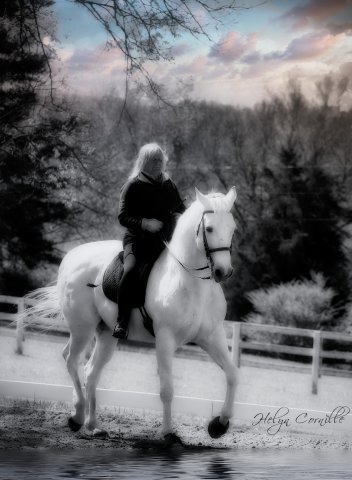
Everyone has experienced these instants of divine harmony where the horse and the rider float in absolute ease and effortlessness. Anxious to recreate these moments, one wears the same shirt than the last time the zone occurred, another pray. A nutritionist wrote a book promising permanent zone through nutrition. These delightful moments can be recreated, but while nutrition is a factor, fashion and faith are wastes.
Without appropriated science, the zone is circumstantial, ephemeral, and mystical. Instead, through the practical application of advanced knowledge, these instants of divine harmony can not only be recreated, but they can become the essence of daily life with the horse. Technically, ease and effortlessness result from maximizing elastic energy through tendons, aponeurosis, and fascia. The elastic energy stored in and recovered from tendons during cyclical locomotion reduces the metabolic cost of locomotion. Muscles do much more than create the forces needed to extend and flex joints, which is what has been traditionally taught in anatomy courses. Instead, most of the length change required for the work of locomotion occurs not in the muscle fibers themselves but by elastic recoil of the associated tendons and muscle aponeurosis. This is a dramatic evolution from the concepts of traditional equitation.
Basically, traditional equitation cannot lead to the zone. Ephemeral circumstances might occasionally create these instants of divine harmony, but obedience to the correct aids cannot maximize storage and reuse of elastic energy through tendon, aponeurosis, and fascia. The wisdom of centuries can be upgraded to actual knowledge, but the words of our ancestors don’t apply to actual knowledge. “Once the horse has overcome his initial clumsiness, he will obey the aids instead of distorting their effects by resistances the origin of which eludes us.” (Academic Equitation, 1949) The horse does not distort the effects of the aids. The horse willingly tries to execute the move protecting his actual muscle imbalance or other dysfunction. Repeating the same aids can only make the horse switch escapes.
The innocence of the correct aids’ concept is clearly illustrated, watching the main forces acting on the horse’s physique during half a stride of half-pass. The educative and therapeutic value of half-pass is the work that the entire horse’s muscular system has to coordinate in order to maintain lateral bending and adequate rotation while moving the body in the direction of the movement.

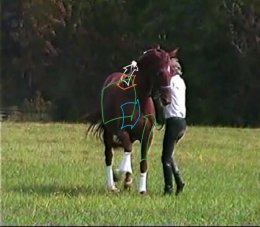
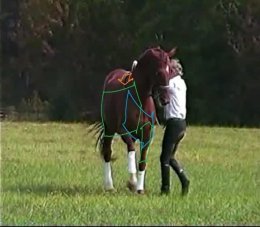
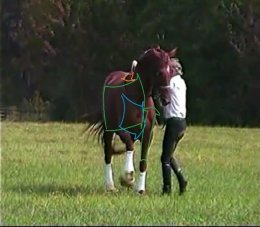
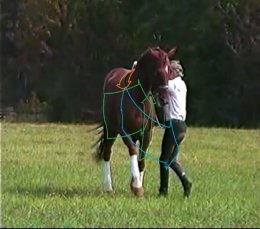
To make it simple and clear, we talk, as an example, about just one of the many forces that the horse has to manage in order to execute half-pass maintaining lateral bending and transversal rotation.
First picture. As the right front leg is off the ground, moving forward and in adduction into the swing phase, the body is supported by the left front leg. The attraction of gravity excerpts a passive rotation attracting the dorsal pines and the right side of the body down to earth, (orange arrow.)
Second picture. The extrinsic muscles of the forelegs and the muscles of the thoracic area counteract the effect of gravity and passive rotation, creating an active rotation shifting the dorsal spine toward the left and allowing forward advancement of the right foreleg, (white arrow).
Third picture. The attraction of gravity is counteracted by the propulsive activity of the right hind leg, which is now into the propulsive phase pushing the body forward to the left. The body is moving toward the left over the left foreleg reducing the attraction of gravity and consequent passive rotation (orange arrow.).
Fourth picture. The propulsive activity of the right hind leg increases, pushing the body forward and toward the left. The body moves even more over the left front leg, and the elevation of the left front leg reduces the effect of gravity and consequent passive rotation (orange arrow).
Fifth picture. As the right foreleg moves in adduction, a slight shift toward the right shoulder occurs, increasing a little the passive rotation created by gravity, (orange arrow). The passive rotation is counteracted by greater propulsive activity of the right hind leg and the work of the foreleg’s extrinsic muscles as well as the muscle of the thoracic spine.
We talk here about just one force, the passive rotation created by the attraction of gravity. In the comparison of the other forces, this passive rotation is a small problem. The physical value of half pass and the therapeutic effect of half pass is the complex and simultaneous muscle work of the horse’s entire body managing at each instant the thrust generated by the hind and front legs It is the muscular work that the horse has to coordinate to maintain lateral bending and proper rotation of the thoracic area while displacing the body in the direction of the movement, that is the physical and therapeutic benefit of half pass. By comparison, the muscular work created by the crossing of the legs is insignificant.
Half-pass is a powerful gymnastic, but only if the rider understands the complexity of the forces interacting on the horse’s physique. Only if the rider creates the body coordination allowing the horse’s physique to manage the large diversity of forces. 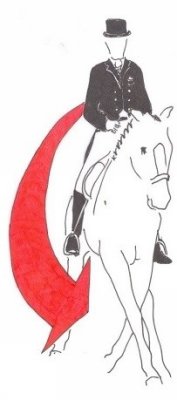 Only if the partnership with the horse is about encouraging the horse’s mental processing to explore sophisticated storage and reuse of elastic energy. If half pass is executed combining lateral bending and inverted rotation, as shown on the picture, the half pass fulfills the judging standards, the horse crosses the forelegs above the knees. Still, the move does not have any athletic and therapeutic value.
Only if the partnership with the horse is about encouraging the horse’s mental processing to explore sophisticated storage and reuse of elastic energy. If half pass is executed combining lateral bending and inverted rotation, as shown on the picture, the half pass fulfills the judging standards, the horse crosses the forelegs above the knees. Still, the move does not have any athletic and therapeutic value.
Jean Luc Cornille


